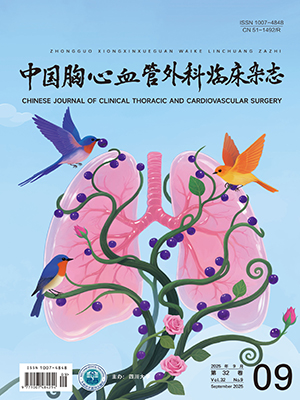| 1. |
Han B, Zheng R, Zeng H, et al. Cancer incidence and mortality in China, 2022. J Natl Cancer Cent, 2024, 4(1): 47-53.
|
| 2. |
Xu J, Ren H, Cai S, et al. An improved faster R-CNN algorithm for assisted detection of lung nodules. Comput Biol Med, 2023, 153: 106470.
|
| 3. |
Petousis P, Han SX, Aberle D, et al. Prediction of lung cancer incidence on the low-dose computed tomography arm of the National Lung Screening Trial: a dynamic Bayesian network. Artif Intell Med, 2016, 72: 42-55.
|
| 4. |
National Lung Screening Trial Research Team. Reduced lung-cancer mortality with low-dose computed tomographic screening. N Engl J Med, 2011, 365(5): 395-409.
|
| 5. |
Nooreldeen R, Bach H. Current and future development in lung cancer diagnosis. Int J Mol Sci, 2021, 22(16): 8661.
|
| 6. |
Sauter JL, Dacic S, Galateau-Salle F, et al. The 2021 WHO classification of tumors of the pleura: advances since the 2015 classification. J Thorac Oncol, 2022, 17(5): 608-622.
|
| 7. |
Murakami S, Ito H, Tsubokawa N, et al. Prognostic value of the new IASLC/ATS/ERS classification of clinical stageⅠA lung adenocarcinoma. Lung Cancer, 2015, 90(2): 199-204.
|
| 8. |
周清华, 范亚光, 王颖, 等. 中国肺癌低剂量螺旋CT筛查指南(2018年版). 中国肺癌杂志, 2018, 21(2): 67-75.Zhou QH, Fan YG, Wang Y, et al. China national lung cancer screening guideline with low-dose computed tomography (2018 version). Chin J Lung Cancer, 2018, 21(2): 67-75.
|
| 9. |
中华医学会呼吸病学分会, 中国肺癌防治联盟专家组, 白春学, 等. 肺结节诊治中国专家共识(2024年版). 中华结核和呼吸杂志, 2024, 47(8): 716-729.Chinese Thoracic Society, Chinese Medical Association, Chinese Alliance Against Lung Cancer Expert Group, Bai CX, et al. Chinese expert consensus on diagnosis and treatment of pulmonary nodules (2024). Chin J Tuberc Respir Dis, 2024, 47(8): 716-729.
|
| 10. |
林耀彬, 林勇斌, 赵泽锐, 等. 《人工智能在肺结节诊治中的应用专家共识(2022年版)》解读. 中国胸心血管外科临床杂志, 2023, 30(5): 665-671.Lin YB, Lin YB, Zhao ZR, et al. Interpretation of Chinese expert consensus on artificial intelligence in diagnosis and treatment of pulmonary nodules (2022 version). Chin J Clin Thorac Cardiovasc Surg, 2023, 30(5): 665-671.
|
| 11. |
Song J, Hwang EJ, Yoon SH, et al. Emerging trends and innovations in radiologic diagnosis of thoracic diseases. Invest Radiol, 2025. [Epub ahead of print].
|
| 12. |
高超, 周小昀, 郭超, 等. 人工智能在胸外科规范化培训教学中肺结节分析与肺段切除规划的应用效果研究. 中国胸心血管外科临床杂志, 2025, 32(4): 469-472.Gao C, Zhou XY, Guo C, et al. Application of artificial intelligence in pulmonary nodule analysis and lung segmentresection planning for standardized training in thoracic surgery. Chin J Clin Thorac Cardiovasc Surg, 2025, 32(4): 469-472.
|
| 13. |
Fang W, Zhang G, Yu Y, et al. Identification of pathological subtypes of early lung adenocarcinoma based on artificial intelligence parameters and CT signs. Biosci Rep, 2022, 42(1): BSR20212416.
|
| 14. |
Tong L, Yang DW, Bai CX. Revelation of American lung cancer prevention and control to China. Int J Respir, 2021, 41(5): 321-324.
|
| 15. |
尹泚, 毛文杰, 李斌, 等. 人工智能系统在肺结节检出及良恶性鉴别中的应用研究. 中华胸心血管外科杂志, 2020, 36(9): 553-556.Yin C, Mao WJ, Li B, et al. Study on the application of artificial intelligence system in the detection and differentiation of benign and malignant pulmonary nodules. Chin J Thorac Cardiovasc Surg, 2020, 36(9): 553-556.
|
| 16. |
苏志鹏, 毛文杰, 李斌, 等. 人工智能辅助诊断系统预测肺结节早期肺腺癌浸润亚型的临床研究. 中国肺癌杂志, 2022, 25(4): 245-252.Su ZP, Mao WJ, Li B, et al. Clinical study of artificial intelligence-assisted diagnosis system in predicting the invasive subtypes of early-stage lung adenocarcinoma appearing as pulmonary nodules. Chin J Lung Cancer, 2022, 25(4): 245-252.
|
| 17. |
梁长虹, 谢辰仪, 吴磊. 肿瘤诊疗新方向: 人工智能与数字化医学图像. 兰州大学学报(医学版), 2023, 49(2): 1-5.Liang CH, Xie CY, Wu L. New direction in cancer diagnosis and treatment: artificial intelligence and digital medical imaging. J Lanzhou Univ Med Sci, 2023, 49(2): 1-5.
|
| 18. |
Salahuddin Z, Woodruff HC, Chatterjee A, et al. Transparency of deep neural networks for medical image analysis: a review of interpretability methods. Comput Biol Med, 2022, 140: 105111.
|
| 19. |
Reid M, Choi HK, Han X, et al. Development of a risk prediction model to estimate the probability of malignancy in pulmonary nodules being considered for biopsy. Chest, 2019, 156(2): 367-375.
|
| 20. |
Liu HY, Zhao XR, Chi M, et al. Risk assessment of malignancy in solitary pulmonary nodules in lung computed tomography: a multivariable predictive model study. Chin Med J, 2021, 134(14): 1687-1694.
|
| 21. |
Xu DM, van Klaveren RJ, de Bock GH, et al. Role of baseline nodule density and changes in density and nodule features in the discrimination between benign and malignant solid indeterminate pulmonary nodules. Eur J Radiol, 2009, 70(3): 492-498.
|
| 22. |
Yang R, Hui D, Li X, et al. Prediction of single pulmonary nodule growth by CT radiomics and clinical features: a one-year follow-up study. Front Oncol, 2022, 12: 1034817.
|
| 23. |
Amrane K, Thuillier P, Bourhis D, et al. Prognostic value of pre-therapeutic FDG-PET radiomic analysis in gastro-esophageal junction cancer. Sci Rep, 2023, 13(1): 5789.
|
| 24. |
Heidinger BH, Anderson KR, Nemec U, et al. Lung adenocarcinoma manifesting as pure ground-glass nodules: correlating CT size, volume, density, and roundness with histopathologic invasion and size. J Thorac Oncol, 2017, 12(8): 1288-1298.
|
| 25. |
Zhu J, Fan Y, Xiong Y, et al. Delineating the dynamic evolution from preneoplasia to invasive lung adenocarcinoma by integrating single-cell RNA sequencing and spatial transcriptomics. Exp Mol Med, 2022, 54(11): 2060-2076.
|




